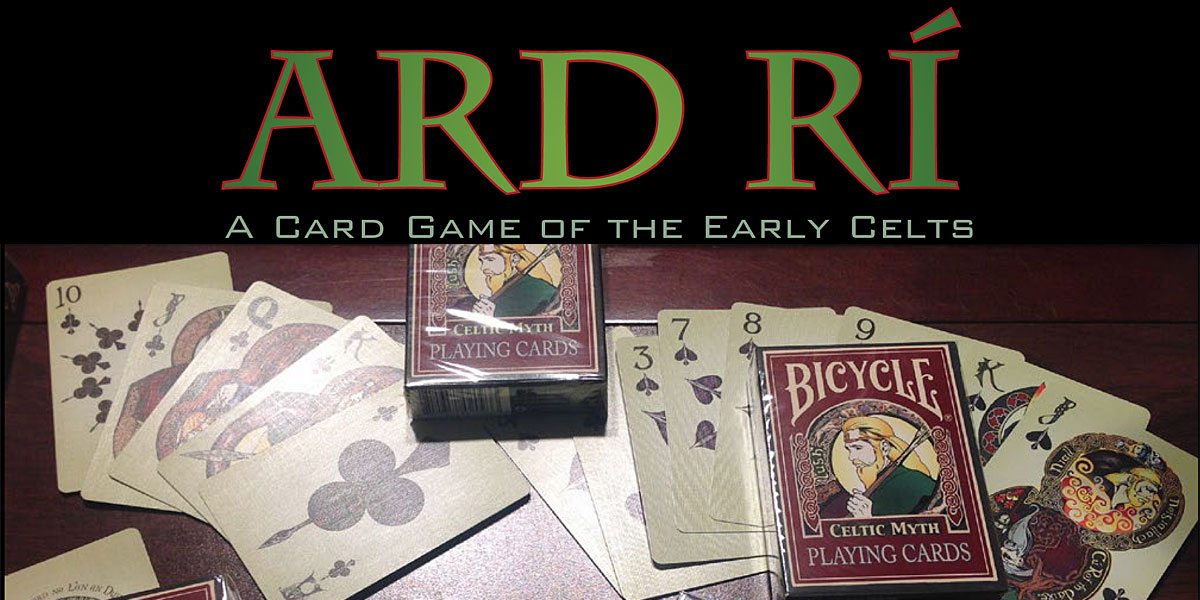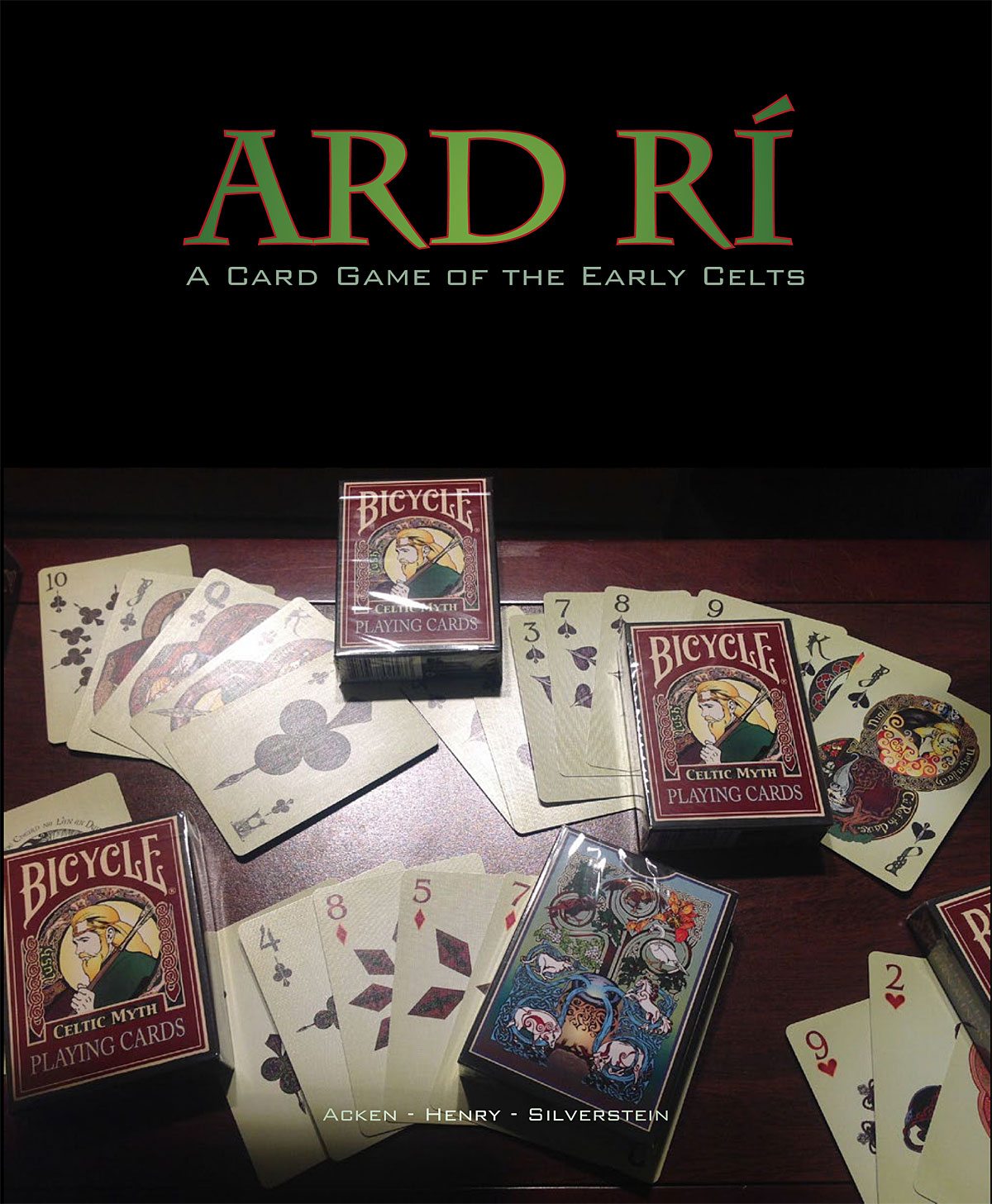 Cultúrlán has done an amazing job at bridging two things that I love–tabletop games and the rich culture and mythology of the Celts. They recently launched their third Kickstarter for the third and final deck in their Celtic Myth Playing Card series.
Cultúrlán has done an amazing job at bridging two things that I love–tabletop games and the rich culture and mythology of the Celts. They recently launched their third Kickstarter for the third and final deck in their Celtic Myth Playing Card series.
While all of the decks can be used as standard poker decks, they are so much more. This third campaign also brings a strategy game that can be played with the decks. But what really makes these decks unlike most themed playing cards is that every detail is carefully and beautifully executed and directly ties to the Celtic lore and mythology of Ireland and Scotland.
The suits themselves, along with the court cards, jokers, and card backs all have deep meaning which is explained in great detail on the Cultúrlán website. All of the cards were designed, illustrated, and detailed by James Acken, a Doctor of Medieval Studies. His knowledge, expertise, and passion for the subject is evident in all of the art on these decks.
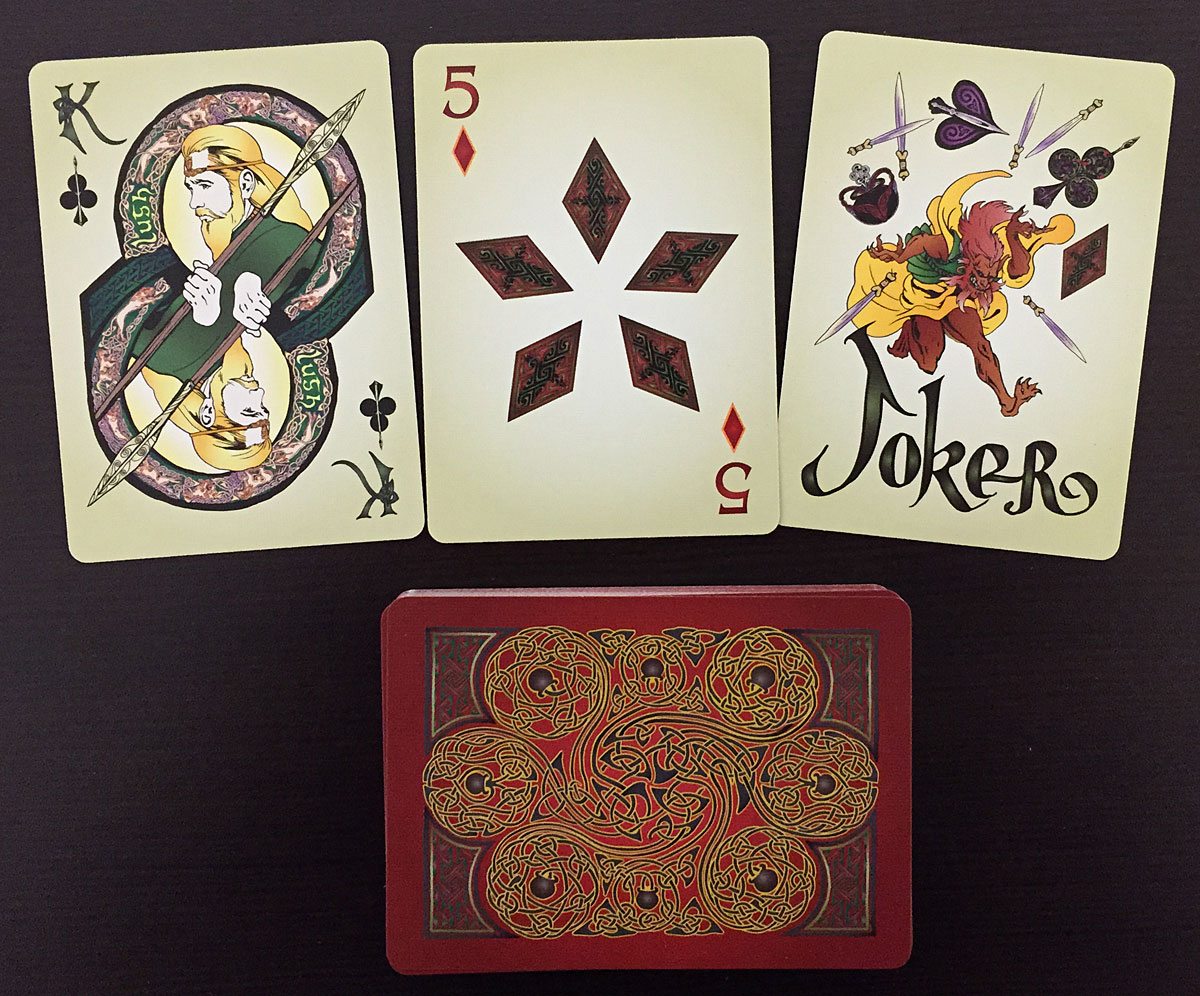 The first deck released, was a symmetrical deck. This deck, like all of the decks, features its own unique card back but shares all of the number card faces with the other decks. The figures on the court cards in this deck feature figures from Celtic mythology representing order and healing.
The first deck released, was a symmetrical deck. This deck, like all of the decks, features its own unique card back but shares all of the number card faces with the other decks. The figures on the court cards in this deck feature figures from Celtic mythology representing order and healing.
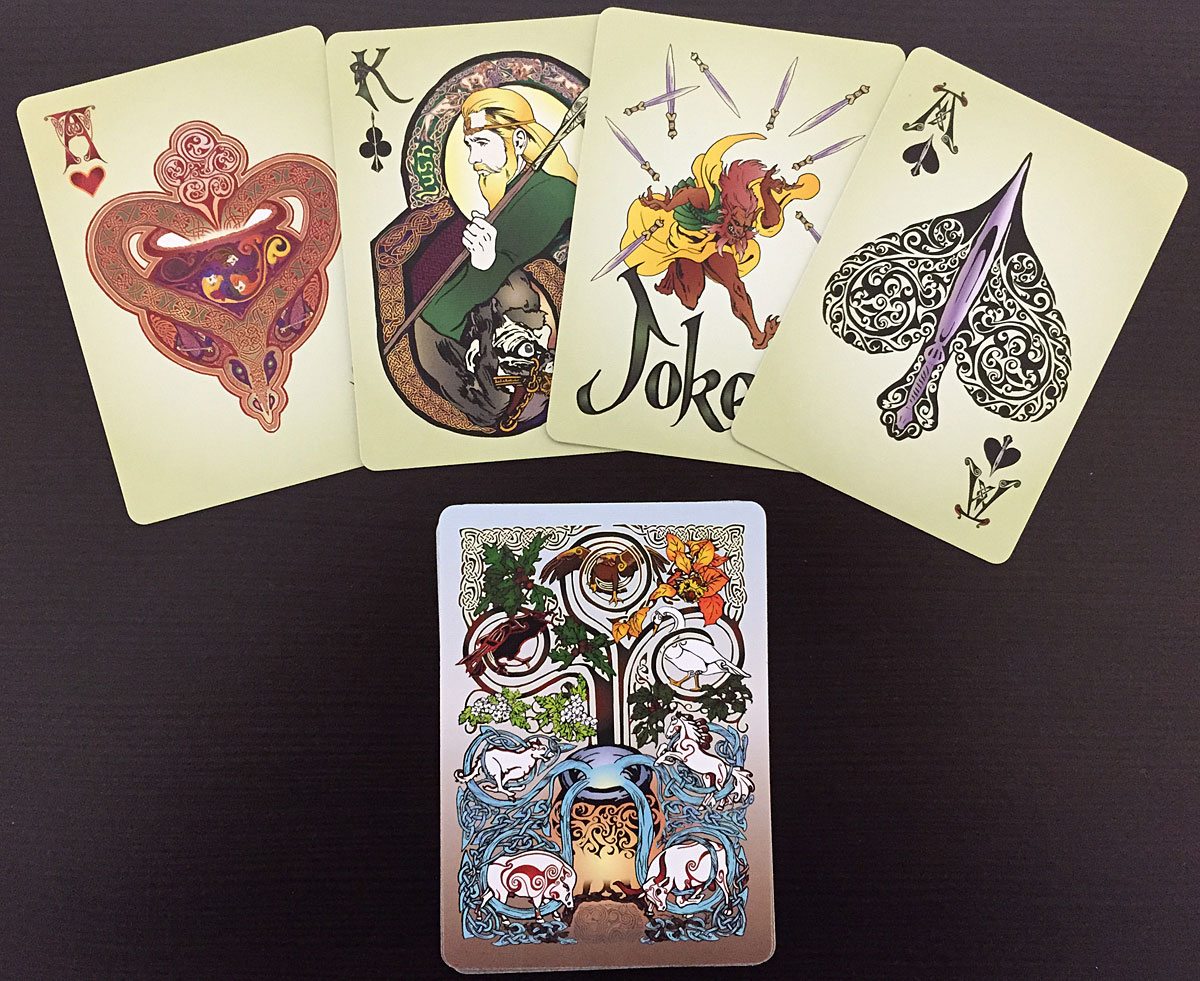 The second, asymmetrical deck features two figures on each court card that are in opposition to each other–one with a leaning towards order and healing versus one who is chaotic and destructive.
The second, asymmetrical deck features two figures on each court card that are in opposition to each other–one with a leaning towards order and healing versus one who is chaotic and destructive.
 The third deck, the main focus of this Kickstarter, is also a symmetrical deck, this time featuring the chaotic and destructive forces on the court cards.
The third deck, the main focus of this Kickstarter, is also a symmetrical deck, this time featuring the chaotic and destructive forces on the court cards.
Even if I were to stop there, I would highly recommend backing this project, which is already almost fully funded. A good, high quality set of playing cards never seems to disappoint anyone, and these are excellent cards of high quality with beautiful artwork interwoven with deep symbolism and meaning.
But Dr. Acken didn’t want to just stop at a few decks of beautiful cards that only briefly touched upon Celtic mythology. He also wanted them to be the foundation of a strategy game, Ard Rí (High King), where two to five players take on the role of ancient Gaelic warlords and struggle to become the High King.
The game can be played three ways–children’s/easy (age five to thirteen), basic play, and advanced play. In the advanced play each court card has special abilities based on the particular figure’s mythology. Only a single deck is needed for two players, two decks for three to four players, and all three decks for a five player game.
My wife and I sat down to play a basic round of Ard Rí using the version 1.0 of the rules. We skipped the easy rules and haven’t yet tried out the advanced play. Though the main rule book contains a lot of Gaelic words which may prove to be a barrier to entry for some folks, the game designers were thoughtful enough to also include an anglicized version of the rules to further simplify learning. We played with the anglicized rules, but, now that we have the rules down, we’ll start introducing the Gaelic to enhance the flavor of the game. There is also a full glossary of all the Gaelic words used to further help along understanding of the strange terms.
Although the game has a deep and complex strategy element to it, we were able to dive in and play through a couple of rounds without thinking too hard about it. Each player is dealt nine cards and the round plays through the four seasons and two Celtic festivals (Bealtaine and Samhain), with the wealthiest player going first during each season. Number cards are cattle so a two is two cattle, a three is three cattle, etc., and the aces representing bulls are worth 15 cattle. The court cards are warriors that eat your cattle and go on raids and hunt to accumulate more wealth for you.
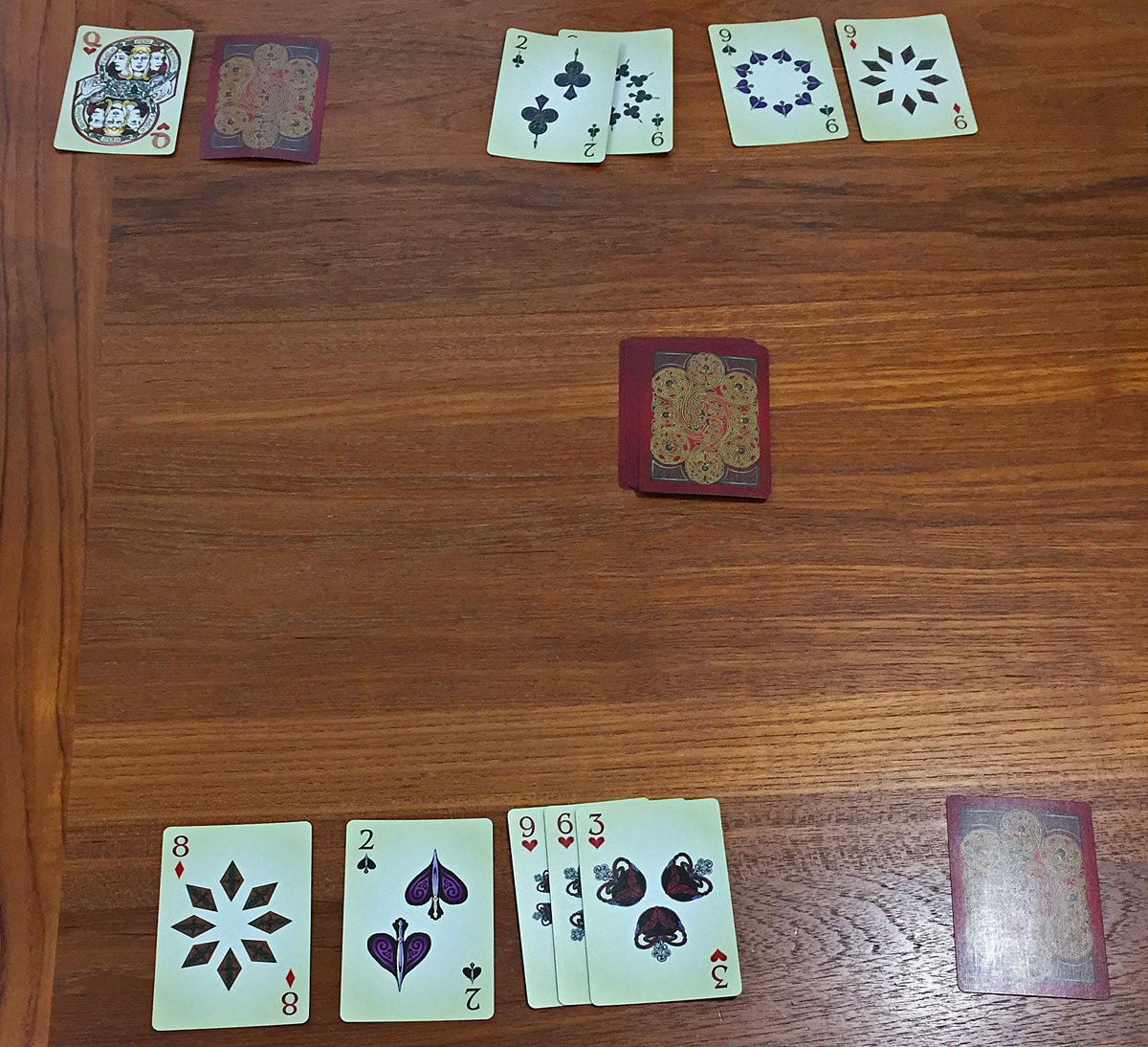 There are several areas on the table where the game takes place. Each player has a cattle field before them where played cattle roam and a round house where their played warriors live. In the middle of the table are the draw pile, a discard pile, the wilderness, and the semi-cultivated lands between everyone’s cattle fields.
There are several areas on the table where the game takes place. Each player has a cattle field before them where played cattle roam and a round house where their played warriors live. In the middle of the table are the draw pile, a discard pile, the wilderness, and the semi-cultivated lands between everyone’s cattle fields.
The game starts in spring when each player plays cattle. A player can play as much cattle as they like as long as they are all of the same suit.
Next comes the high feast of Bealtaine. This is really just a checkpoint in the game where you must have cattle in your field. If Bealtaine comes and you have no cattle, your people leave you and you are eliminated from the game.
During summer, players play warrior cards into their roundhouse. Warriors are put in to play face down indicating that they are inexperienced (and keeping who they are a secret from your opponents.) At harvest time, the warriors you have will need to be fed five cattle points each, so be careful to only play warriors you can feed or risk losing them.
Summer turns to autumn when players harvest cards from either the draw pile or the wilderness. The wealthiest player who goes first only gets to draw a single card, followed by two for the second player and so on. This is a great way to balance out being wealthiest.
Samhain and the harvest feast come next at which point warriors are fed five cattle each. Proven warriors must be fed but unproven warriors do not. If an unproven warrior is not fed, he leaves your roundhouse to go into the wilderness and becomes proven. The warrior is also now available for someone else to take during the next autumn. Players discard cattle from their field to feed their warriors. Any overpayment is not returned; for example, a player has two warriors and only an eight and a three cattle in her field. To feed both warriors, all eleven cattle are discarded.
The final season of the round is winter. Winter is when the bulk of the action takes place. A player has three options for winter–hunting, raiding, or politicking.
To hunt, a player draws three cards from the draw deck plus one card for each proven warrior in their roundhouse they want to use. An important note is that a warrior can only take one action, so a warrior sent to hunt cannot be used to defend on another player’s turn. Think of all players’ actions taking place simultaneously during the season
To raid, a player chooses how many warriors they want to send and to which opponents cattle field they are being sent. Just like with hunting, a warrior sent to raid cannot be used to defend on another player’s turn. Sending a warrior on a raid makes him proven so even a field with no cattle can be raided. No wealth can be gained, but the warrior will become proven.
The defending player has a couple of options. Any proven warriors must defend, but unproven warriors do not and can let raiders through. Raiders and defenders are paired one-to-one, with Kings stronger than Queens and Queens stronger than Jacks. The weaker warrior goes to the discard pile. In the event of a tie, both warriors are discarded.
A successfully raiding warrior gets to steal cattle. If there are cattle that match the suit of the warrior, the warrior takes all cattle that match that suit. If there is not a match, the warrior can choose any single cattle to steal. All warriors and cattle involved in the raid stay in the semi-cultivated lands until the end of the season. This means any warriors or cattle involved in a raid are locked.
The last option for winter is politicking. If a player wants to attempt to win the game, they can try to force the other players to declare them Ard Rí. This is done be sending a gift of cattle to two opponents simultaneously (or just the other player in a two-player game.) The gift consists of one cattle from each suit. If the opponent does not have cattle that can match the gift, he must accept the gift and declare the player Ard Rí. If the gift can be matched or bettered, the player can send warriors to enforce the gift and the battle rules from raiding apply. If the player sending the gift still loses, the gift is kept by the opponent and play continues on.
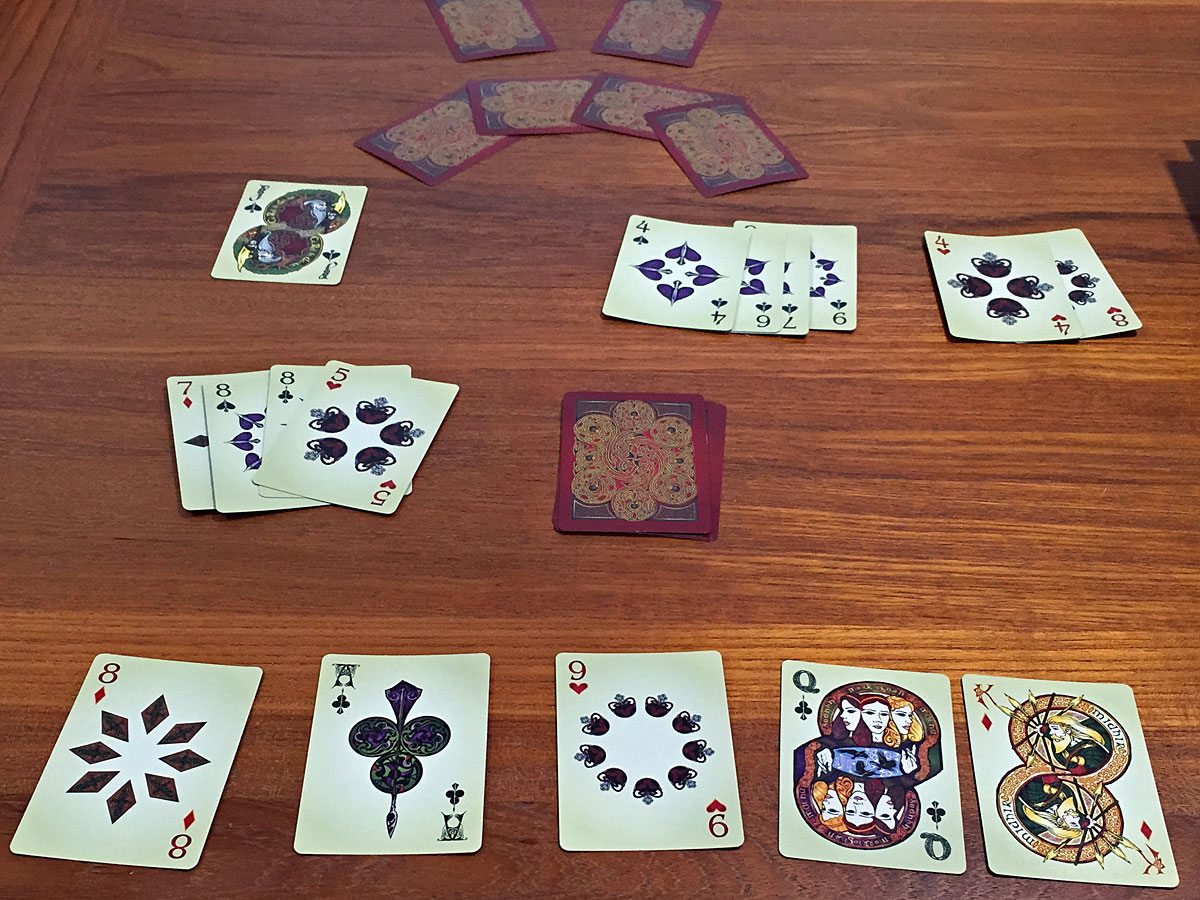 I know that sounds like a lot of rules, and I have to admit that when I first looked at them I was a bit overwhelmed. However, we took it one season at a time, and after two rounds we weren’t even looking at the rules anymore. The only time we referred back to the rules was when I wanted to verify how to do politicking after about 30 minutes, at which point I sent my cattle gift and won the game. It was only ten minutes in when my wife proclaimed, “This is really fun! I love this game!”
I know that sounds like a lot of rules, and I have to admit that when I first looked at them I was a bit overwhelmed. However, we took it one season at a time, and after two rounds we weren’t even looking at the rules anymore. The only time we referred back to the rules was when I wanted to verify how to do politicking after about 30 minutes, at which point I sent my cattle gift and won the game. It was only ten minutes in when my wife proclaimed, “This is really fun! I love this game!”
 In advanced play, each of the court cards has special abilities that add to the strategy and complexity of the game. The special ability is based on the actual mythology of the character, which is beautifully detailed in the rule book. While it would be nice for this info to be on the card itself, the beauty of the cards would suffer–so looking it up in the rulebook is worth it. We’ll definitely be trying out the advanced play once we have a few more playthroughs under our belt.
In advanced play, each of the court cards has special abilities that add to the strategy and complexity of the game. The special ability is based on the actual mythology of the character, which is beautifully detailed in the rule book. While it would be nice for this info to be on the card itself, the beauty of the cards would suffer–so looking it up in the rulebook is worth it. We’ll definitely be trying out the advanced play once we have a few more playthroughs under our belt.
Finally, Dr. Acken was gracious enough to sit down with me for a quick interview about the game.
GeekDad: I have a history degree myself–I specifically studied Medieval European history with a focus on Scotland and women’s roles–but I went off after college and got into software. What got you into history as a profession and why the focus on Celtic mythology?
James Acken: Speaking for myself, the question was not one so much of history as culture–the aggregate of priorities that make us choose one set of things over another and how that intersects with individual perception. I became acutely aware in my late twenties that the perceptions and priorities current in my socio-political landscape (the Anglophonic world really) were defined by socio-political developments that occurred in the Middle Ages. I was working as a freelance artist and volunteer social-worker at the time, but it became clear to me that I was well out of my depth and would need to understand the massive forces at work in our society before I could make a real difference to people. Studying the Middle Ages and becoming a teacher seemed to check all the boxes.
The Celtic connection was a bit of a surprise. It came as a result of visiting Scotland when I was fifteen. The spark that ignited then grew and grew until I just felt that I needed to learn all I could about that culture. When I entered graduate school it became clear that what I understood as Scottish culture was in fact learned Gaelic tradition and was centered in Irish medieval tradition. I did not want to be limited to that, however, so I focused on the poetic cultures of the North Sea, including Norse, Anglo-Saxon, Norman, Latin, and Welsh traditions. My heart, though, is in the Gaelic tradition so I naturally gravitate there.
I should also say that my focus is not so much on the mythology as the aesthetic tradition, though this is deeply and intrinsically informed by the mythology. In North America particularly there is an unspoken assumption that one can take literary and mythic figures like Arthur and the Mórrioghan out of their linguistic and historical context without damaging them. This is a terrible fallacy. One cannot separate the mythology from the language or the history from the landscape, and it’s this sense of context that I think people are craving. The art, the games, the things we make, it’s all about bringing the context of the mythology into our world and our time, so it’s also about finding a context for the myths in the modern landscape of the internet and our busy schedules.
GD: How did you come up with the idea to turn your love of history in to a game?
JA: That’s a much larger question than it seems. Games are everything. We understand the truth of it when we are young, when play is how we assert meaning in our lives, but there’s this pressure to outgrow games and play. This is not only absurdity; it’s evil. To give up gaming is to give up really living. I don’t want to get lost in writing a treatise on the virtues of gaming, but suffice it to say that humanism reaches its apotheosis when people gather at a table and play a game. Ducking out from under the massive theoretical issues at play, I’d answer your question most directly by saying that games are the best way to get people to engage with whatever you want people to engage with because they’re fun. I always start every class I teach by taking students back to the original meaning of the word studium–the word from which we get “study.” It meant “zeal or enthusiasm” and not “hard work, memorization, and obliged intellectual activity.” I struggled to get my students to really grapple with the material we’d cover, so it made sense to come up with a way to make it truly enjoyable. It’s the difference between a living culture and a corpse that you’re dissecting. Make it a game and it’s alive. Make it the subject of an academic course and it’s dead.
Ducking out from under the massive theoretical issues at play, I’d answer your question most directly by saying that games are the best way to get people to engage with whatever you want people to engage with because they’re fun. I always start every class I teach by taking students back to the original meaning of the word studium–the word from which we get “study.” It meant “zeal or enthusiasm” and not “hard work, memorization, and obliged intellectual activity.” I struggled to get my students to really grapple with the material we’d cover, so it made sense to come up with a way to make it truly enjoyable. It’s the difference between a living culture and a corpse that you’re dissecting. Make it a game and it’s alive. Make it the subject of an academic course and it’s dead.
GD: As a geek dad of a two-year old, it’s been challenging to find time to have game nights and get people together. How do you find time to not only play but make games being a dad yourself?
JA: Two years old? Yes, that is tough! For that age you need something really simple–like fuzzy dice simple! Mine are nine, seven, and five (with another due in September). They’re my cohort of play-testers! If they get it, I can count on anyone getting it, and they’re always willing to make suggestions and try changes. The adult game-nights are much rarer, but they do happen.
I also have to say that if your heart is really dedicated to something you’ll be doing it even when there’s no-one to do it with. I remember not having anyone to game with before high-school, so I used to stay up at night under a sheet in my room with a flashlight rolling dice to generate random dungeons for my own D&D characters out of the old first edition DM’s guide. You just find a way if it’s what you want. I wrote my first game when I was twelve. It was terrible, and when I tested it with my brother and cousins it turned into a horrible joke, but it didn’t stop me. I’ve always been fascinated with game mechanics and the tension between narrative and mathematics. It’s what makes games so enticing–the interaction of mechanics with the story everyone at the table is trying to tell generating an emergent story that no-one can predict. It’s fascinating!
GD: Do you have any plans to release the rules for Ard Rí to backers before the end of the Kickstarter to get any feedback before finalizing the game?
JA: Absolutely! We’re releasing a “print-and-play” version where you can download a PDF of the full rules to play with the cards. We’ve even come up with different versions of the game: an introductory version that is very simple and easy to learn, a basic version that you can play with any deck, and an advanced version that you’d really need one of our decks to play as each court card has special abilities tied to the legendary figure represented. Cú Chulainn our Jack of Clubs, for example, has his ríastartha (warp-spasm) that allows him to fight everyone involved in a combat. We want people to play the game and participate in the process of making it as fun a game as it can be.
We’re also not married to the rules as they are, though we genuinely feel that we’ve done a pretty good job in creating a solid game. The version of the rules released during the Kickstarter is basically version 1.0, but it will evolve, I am sure. Just as poker has so many different variations, I would love to see people taking Ard Rí and making it something they’re personally invested in. Our goal was to come up with a game that people enjoy so much that they want to play it in different ways and change it to their liking. I really don’t think it will ever be truly “finished,” but I think we’ve taken it to a place where people can have fun with it in a number of different ways. There’s nothing like getting your herds of cattle to a place where you can support a proper war-host and then send them on a full-scale invasion of your opponents. You may not know what will happen, but it’s a fine thing to see all the same!
I think the best way I could put it is to say that the card game is going to be our jumping-off point. We’re already talking about a boxed table-top version with mats and maybe even miniatures that really focuses on the myths and the warfare, and that is completely separate from a digital version that we’re working towards that will allow online play without the physical cards!
GD: When and how did you first get in to gaming?
JA: I’ve always been into gaming! From playing gin with my grandfather, D&D with my grade-school buddies, to a kind of proto-LARPing with wooden weapons we made in our barn when I was growing up, games have always played a large part in my life. There’s never been a time without them.
GD: A lot of us gaming geeks dream of creating our own games. I know I have several ideas bouncing around in my head at any given moment that I’d love to see in the real world. How did you get in to creating games, and do you have any tips on where people can get started?
JA: Just after college I was working as a volunteer in London. I met a fellow there whose great love was game design. I remember him telling me about how he had designed games for Avalon Hill and other big companies but had only taken payment in Magic cards. On the one hand, I was shocked. This guy needed to be paid millions. The games he and his friends designed were brilliant, but they weren’t designing them to get rich. They just loved the challenge, the social pleasure, the GAME of it all. (They actually have their own company now: The Ragnar Brothers.) It was a big lesson for me because it was the first time I realized that the heart of a great game is the social aspect, and these guys had it down. Every few days they’d get together and just play games they were designing. It wasn’t for the paycheck or the recognition. It was for the fun, which is what it’s all about anyway. If you want to get into game design, in my opinion, that’s where it begins and ends–having fun with other people.
To be honest, though, my friends Todd and Jay are the real game-designers in the group. This is my first real undertaking in publishing a game, but they’ve had solid experience on this one. I’d love to hear how they’d answer this question.
GD: Something along the lines of “Being a geek isn’t about what you love but how you love it” is sort of the new geek mantra. Do you have anything, besides games and Celtic history and mythology, that you consider yourself a geek about?
JA: That’s a great way to define it. Yeah, I’d have to say narrative, which means movies and television shows are something of an obsession for me–oh, and grammar. Don’t get me started on language… or Disney. My wife accuses me of participating in the Cult of Mouse. I just think what Disney created is completely fascinating, but I don’t think I can claim to be a geek about it since my brother bested me in obscure Disney knowledge this past February. I dream of being able to shape an experience the way Disney does, though some of the Disney magic has its cautionary elements as well. I was a pretty hardcore console gamer as well for decades, but I’ve let it go over the last four years or so. There’s so much other stuff to do! I wouldn’t mind developing for consoles, though. I’ve already got one based on the Táin Bó Cuailgne sketched out.
GD: Do you have a favorite console game from your gaming years?
JA: I have to say that despite my ongoing (sometimes vexed) admiration and love for Bethesda’s games, Halo has yet to be eclipsed. I should also add that its various producers have yet to surpass the achievement of the first game, so Halo: Combat Evolved is still one of my all-time favorites mostly because it was so successful at drawing you into one story and then veering in an unexpected direction without losing its ability to combine its aesthetic elements–graphics, music, sound effects, dialogue–seamlessly to keep the pacing just right. It was still a ride, though, with a single storyline that you had no choice but to follow.
Unfortunately, I’ve not been able to keep up with the turn console gaming’s taken since the release of the PS4 and the Xbox One. I like the high production values, but I’ve yet to see anything that’s really done something significant in terms of game-narrative. The thing I find fascinating about games is the degree of interactivity that it opens which offers the potential for non-linear narrative. There’s a clear potential to use unique aspects of Gaelic narrative tradition in that context, but it’s just not happened yet. Hopefully we’ll be able to change that.
GD: And what about a favorite Disney film or story?
JA: Now for my favorite Disney movie–I’d have to say that there’s not just one. I’ve more got a favorite period–1944-59, basically Three Caballeros to Sleeping Beauty with ’46-’50 being the pinnacle. That’s the period when the studio’s palette was at its darkest and their animation at its most unabashedly surreal. Bambi, which I know was earlier, is perhaps one of their greatest achievements in my opinion because they actually changed the animation to match the mood. It’s almost expressionistic in that way. I know most people think of that really cutesy animation when he’s just a fawn, but as he grows the animation changes style, always reflecting the inner realities of the characters. By 1945 when they released the short Duck Pimples, they’d really hit a stride in combining line, color and story to serve the overall effect and intent, but they’d not yet become reliant on any successful formula.
I could go on like this for ages. I’ve been meaning to work all these kinds of views into a blog, but with everything I’m trying to get done… well the line from Alice in Wonderland springs to mind: “Time! Time! Who’s got the time!?”
GD: You mentioned you were fans of GeekDad.com. Do you remember how you first found us and started following us?
JA: It was a coalescing of different sources, some real and some online. Todd and Jay were following it before I was, but that’s probably because I was out eating ants or something. They suggested it, a couple other friends suggested it, some of my Facebook friends suggested it, and I came across some articles independently as well, so it was really no one source, to be honest. I really like where you guys are at and applaud the work you’re doing! It’s all after my own heart!
For more details about the cards, the art, the lore and Dr. Acken, please visit their Kickstarter and help bring the final piece of this wonderful saga to life.
Note: I was sent review samples of the first two decks and a print-and-play of the version 1.0 of the rules for Ard Rí.
